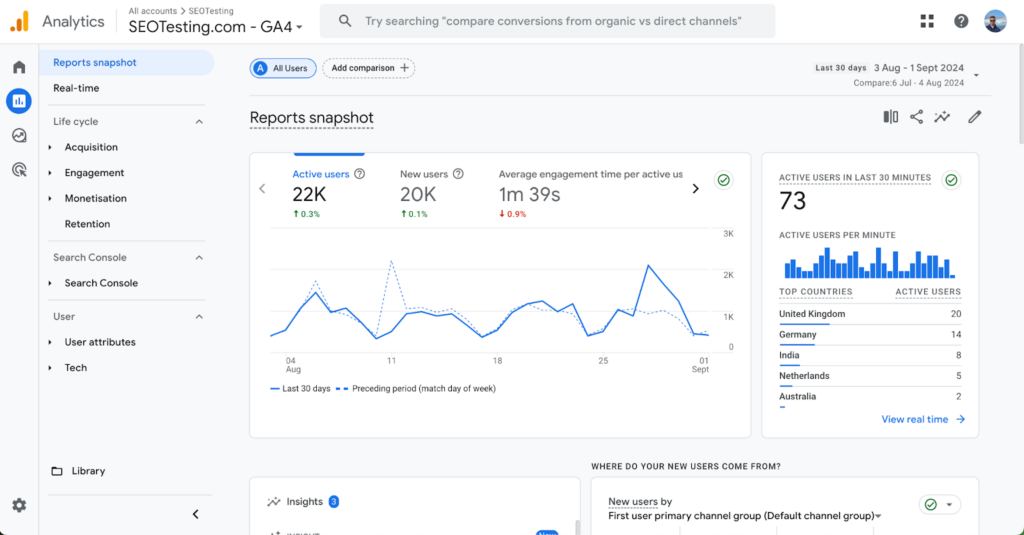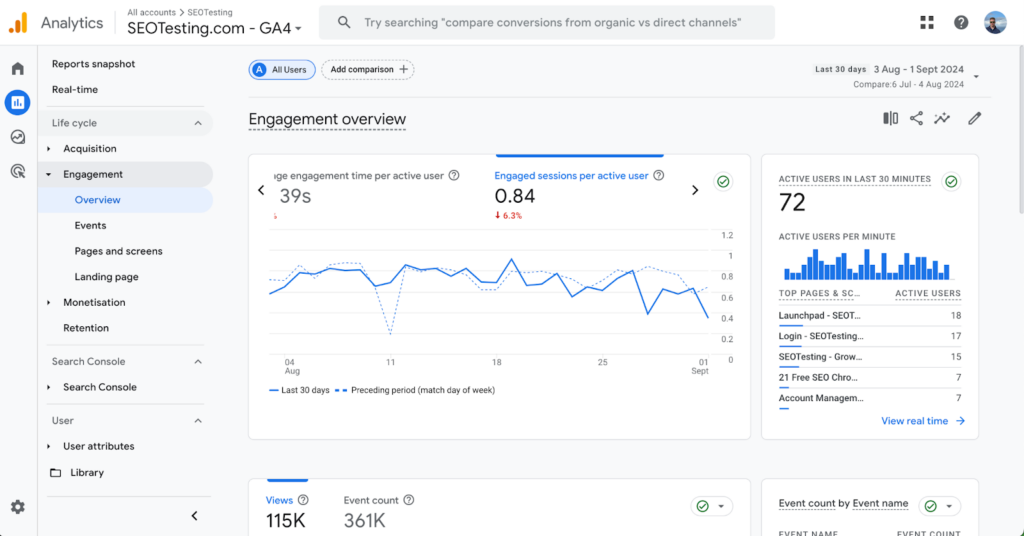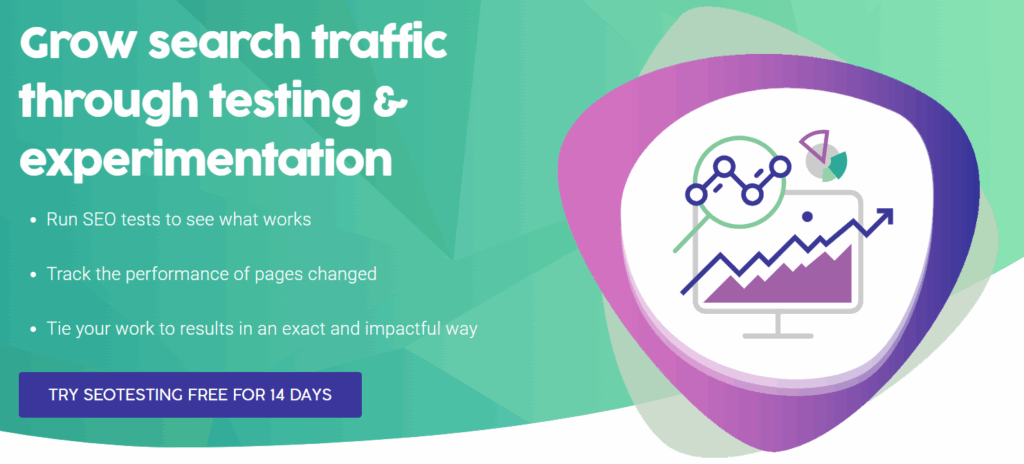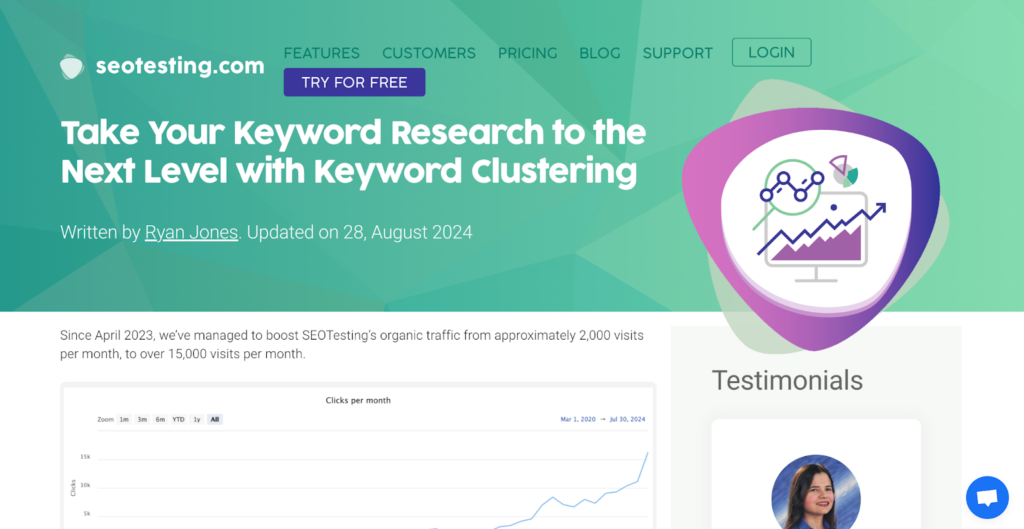In GA4, an engaged session is a user that simply meets one or more of the following criteria set by Google:
- It’s a session that lasts longer than ten seconds.
- It’s a session that includes at least two pageviews or screenviews.
- It’s a session that includes a key event, such as:
- Clicking on a CTA
- Using the search bar on the website
- Signing up for a newsletter.
A session that doesn’t meet these criteria is called a bounce.
For example, within our own GA4 account, we have certain events listed as key events:

So, if I were to head to the SEOTesting website and click on our Google Search Console content hub, I would be classed as an engaged session as I completed a key event. If I had simply landed on the homepage, scrolled around for a few seconds, and left, I would not be classed as a key event.
Top Tip: You can use custom audiences in GA4 to view your site’s data from the point of view of a specific audience segment. Check out our GA4 audience guide to learn more about what custom audiences are and how to create them.
Engaged sessions per user
To get the complete picture of your website’s user engagement, you also need to consider the engaged sessions per user metric. This metric goes a step further by showing how often each user on your site engages with your content, offering much deeper insights into the quality of their interactions.
Simply put, the engaged sessions per user metric is the average number of engaged sessions that a single user initiates during their time on your site.
This doesn’t just tell you whether users engage with your content but also shows how consistently they engage. A higher number indicates that your content attracts users and persuades them to return and engage multiple times.
Finding this metric within GA4 is straightforward.
Start by navigating to the “Reports” section in your GA4 dashboard:

From there, head to the “Engagement” report, where you will find the engaged sessions per user metric easy to find:

This report allows you to monitor trends and assess how effectively your content keeps users engaged over time.

How does GA4 calculate sessions?
In GA4, sessions are calculated differently from Universal Analytics, and this was done to reflect a more user-centric approach to tracking and measurement. Not to mention the transition to an events-based tracking system, precisely what GA4 is.
GA4 calculates sessions by considering five things: session initiation, session continuation, session duration, cross-device tracking, and session IDs.
Session initiation
A session within GA4 starts when a user interacts with your website (or app) for the first time. This interaction could be any event, such as:
- Viewing a page
- Clicking a button
- Starting a video
Unlike Universal Analytics, where sessions heavily rely on page views, GA4 sessions are event-driven, providing more flexibility and accuracy in tracking user interactions.
Session continuation
Once a session starts, GA4 monitors and records all subsequent events the user triggers until that session ends. Every action a user takes, whether going to a different page, downloading a PDF, or making a purchase, is tracked as part of that session.
Session duration
By default, a session in GA4 ends after 30 minutes of inactivity. If the user resumes any activity after this limit, a new session is started.
Unlike Universal Analytics, where a session would automatically reset at midnight or if the campaign source changed, GA4 maintains the session until the user stops interacting. This ensures you get a more accurate representation of user behavior across your website.
Cross-device tracking
As we mentioned in our GA4 guide, GA4 incorporates cross-device tracking. This allows sessions to be calculated across multiple devices and platforms. If a user starts a session on their mobile device and continues it on their laptop, GA4 can stitch these interactions into a single session.
Session IDs
Every session is assigned a unique session ID to group all events occurring within that session. This ID helps ensure that all actions the user takes within the session time frame are accurately attributed to the correct session.
Why are engaged sessions useful for marketers?
Understanding engaged sessions is important for marketers. In this section, we will explain why.
Measure user engagement
Engaged sessions are a tool for marketers to measure user engagement effectively.
By analyzing the length, depth, and frequency of these sessions, you can gauge how deeply users interact with their content. This data helps you understand whether the content resonates with the audience or not, which helps to reveal the quality of engagement beyond simple metrics like clicks or visits.
Improve audience insights
Engaged sessions provide much-improved audience insights. These sessions offer a clearer picture of user behaviors, preferences, and interests. You can segment audiences more accurately and tailor marketing campaigns to different user groups based on their engagement levels. This granular insight ensures that marketing efforts are more targeted and effective.
User experience optimization opportunities
You can also use engaged sessions to highlight opportunities to optimize your website’s user experience.
By studying where users spend the most time on your website or where they drop off, you can identify friction points or areas that need improvement. Enhancing your site’s user experience based on this data can lead to longer sessions and higher user satisfaction, ultimately increasing overall engagement.
Tracking content performance
Tracking content performance is another benefit of monitoring engaged sessions. You can pinpoint which content pieces hold your users’ attention the longest and which fail to do so.
This insight allows for better content planning, ensuring that future materials align with what your audience finds valuable and engaging.
Enhance conversion strategies
Engaged sessions also help you enhance conversion strategies.
When you understand what interactions lead to successful conversions, you can refine your strategies to replicate these successes. This data-driven approach ensures that resources are focused on the tactics that are most likely to drive conversions.
What happened to the bounce rate metric?
Within GA4, the traditional bounce rate metric was removed, which caused some confusion among marketers who were familiar with Universal Analytics. However, Google introduced a new concept called engagement rate, which is treated as a replacement for the bounce rate metric.
In Universal Analytics, bounce rate was the percentage of single-page sessions in which users left the site without further interaction. This statistic was helpful, but it could sometimes be misleading because it didn’t account for the time spent on the page or other engagements.
For example, if a user landed on our blog post about keyword clustering:

They found that the information was all there, and they did not click anything else, so they left the page. Universal Analytics would have classed that as a bounce, even though, technically, we fulfilled user intent by giving them all the information they needed.
Engagement rate solves that.
Since the event will have lasted longer than ten seconds, this would now be classed as an engaged session, which is much more helpful to me, as a marketer, than a bounced session where we fulfilled user intent.
Wrapping things up
Understanding the concept of an engaged session in GA4 is crucial for any marketer who wants to gain a clearer picture of user behavior and content performance.
GA4 provides a more nuanced and accurate representation of how users interact with your website by focusing on engaged sessions rather than the traditional bounce rate. This shift towards measuring meaningful engagement allows you to optimize your strategies, enhance user experience, and ultimately drive better results.
Whether tracking content performance or improving audience insights, engaged sessions are a tool that can lead to more informed decisions and greater marketing success.
If you are looking for a tool that can accurately track whether your changes have been effective using data from Google Search Console and GA4, give SEOTesting a try. We have a 14-day free trial with no credit card required, so sign up today.


